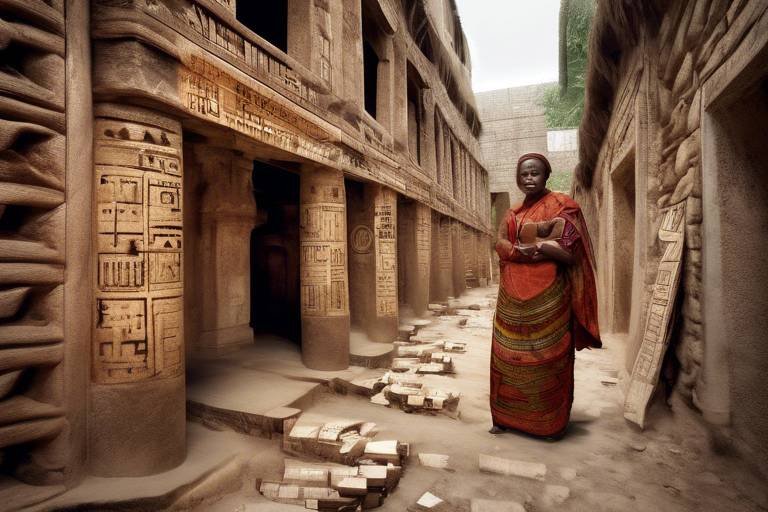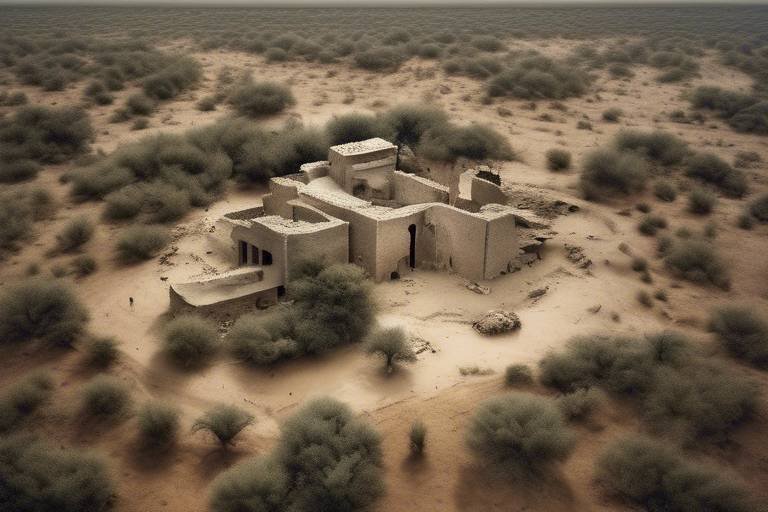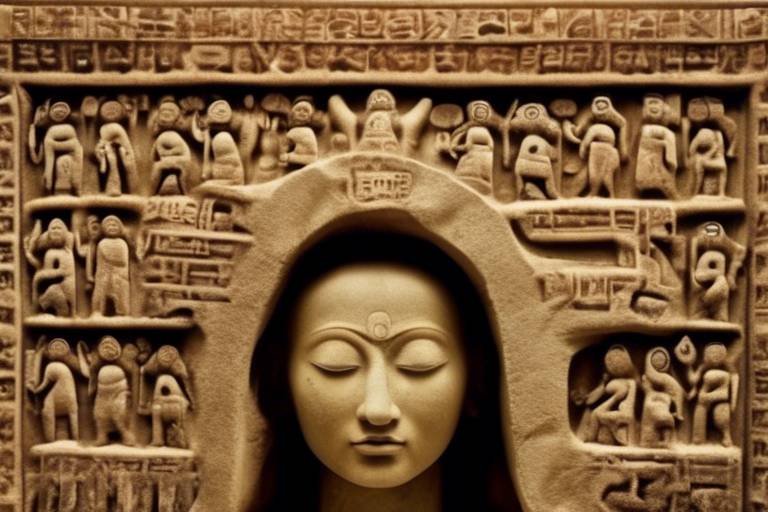The Role of Technology in Cultural Heritage Education
Technology plays a pivotal role in transforming the landscape of cultural heritage education, revolutionizing the way we explore and engage with our rich history and diverse traditions. By seamlessly integrating innovative technological tools and platforms, the immersive learning experience of cultural heritage has reached new heights, captivating audiences worldwide.

Virtual Reality in Cultural Heritage Education
Virtual Reality (VR) technology has revolutionized the field of cultural heritage education by offering immersive experiences that transport learners to distant lands and ancient civilizations. Through VR, individuals can explore historical sites, experience significant events, and walk through cultural landmarks as if they were truly there. This innovative approach goes beyond traditional learning methods, providing a deeper understanding and appreciation of our rich heritage.
Imagine stepping into the majestic pyramids of Egypt, walking the streets of ancient Rome, or witnessing the grandeur of the Taj Mahal, all from the comfort of a classroom or home. VR allows users to engage with history in a way that textbooks and lectures cannot match. By creating a sense of presence and interactivity, VR brings cultural heritage to life, making learning a truly immersive and unforgettable experience.
Furthermore, VR technology enables educators to design educational programs that cater to different learning styles and preferences. Visual learners can benefit from realistic 3D reconstructions, auditory learners can engage with narrated stories, and kinesthetic learners can interact with virtual environments. This personalized approach enhances retention and understanding, making cultural heritage education more accessible and engaging for all.
Additionally, VR experiences can be enhanced with interactive elements such as quizzes, challenges, and guided tours, turning passive learning into an exciting adventure. By gamifying the learning process, VR encourages exploration, curiosity, and active participation, transforming education into a captivating journey through time and culture.

Augmented Reality Applications in Museums
Augmented Reality (AR) has revolutionized the museum experience by seamlessly blending the physical world with digital elements, creating an interactive and engaging environment for visitors. Museums are leveraging AR applications to offer innovative ways for patrons to interact with exhibits and artifacts, providing a deeper understanding of cultural heritage.
One significant application of AR in museums is the overlaying of digital information on physical artifacts. This technology allows visitors to access additional historical context, interactive visuals, and multimedia content related to the exhibits they are viewing. By simply pointing a mobile device at an artifact, users can unlock a wealth of information that enhances their learning experience and brings history to life in a unique way.
Moreover, AR facilitates interactive storytelling within museum settings. Visitors can engage with AR-powered exhibits that present narratives in a dynamic and immersive manner. Through animations, audio guides, and interactive elements, AR applications make the learning process more captivating and memorable, appealing to a wide range of audiences, including children, students, and adults.
By incorporating AR technology, museums can transform traditional exhibits into interactive learning experiences that cater to the digital-savvy generation. Visitors are encouraged to explore cultural heritage in a hands-on and educational way, fostering a deeper connection with history and heritage. AR applications in museums not only enrich the visitor experience but also contribute to the preservation and promotion of cultural traditions for future generations.

Digital Archives and Preservation Efforts
Exploring how technology enhances the learning experience of cultural heritage, from virtual tours of historical sites to interactive exhibits in museums, and its impact on preserving and promoting diverse cultural traditions for future generations.
Utilizing VR technology to create immersive experiences that transport learners to ancient civilizations, historical events, and cultural landmarks, fostering a deeper understanding and appreciation of heritage.
Exploring how AR enhances museum visits by overlaying digital information on physical artifacts, providing interactive storytelling, and engaging visitors in a dynamic and educational way.
Discussing the role of digital archives in preserving cultural heritage through digitization of artifacts, documents, and artworks, ensuring their accessibility and conservation for future generations.
Digitization has revolutionized the preservation of cultural heritage by creating digital archives that store valuable artifacts, documents, and artworks in a secure and accessible manner. These digital archives not only protect the physical integrity of historical items but also ensure their longevity and availability for future generations to study and appreciate. By digitizing cultural heritage, we are safeguarding our past and making it more accessible to a global audience.
Examining the benefits of online platforms in delivering cultural heritage education to a global audience, offering courses, workshops, and resources on diverse cultural traditions and historical events.
Exploring how mobile apps offer interactive guides, historical information, and virtual tours of cultural sites, enabling users to explore and learn about heritage locations anytime, anywhere.
Analyzing how interactive exhibits and gamification techniques in museums and heritage sites engage visitors of all ages, making learning about cultural heritage fun, interactive, and memorable.
Examining the role of social media in promoting cultural heritage, fostering community engagement, and raising awareness about preservation efforts, encouraging dialogue and participation in heritage initiatives.
Highlighting how technology facilitates cultural exchange programs, connecting individuals from different backgrounds, fostering cross-cultural understanding, and promoting appreciation for diverse heritage traditions.
Q: How does technology contribute to the preservation of cultural heritage?
A: Technology plays a crucial role in preserving cultural heritage through digitization, virtual experiences, and online platforms that ensure accessibility and conservation of artifacts and traditions.
Q: What are some examples of technology-enabled cultural exchange programs?
A: Virtual exchange programs, online workshops, and collaborative digital projects are examples of how technology connects individuals globally to share and appreciate diverse heritage traditions.
Q: How can social media be used to raise awareness about cultural heritage preservation?
A: Social media platforms can be utilized to showcase cultural heritage sites, share educational content, and engage communities in discussions about the importance of preserving and promoting diverse heritage.

Online Learning Platforms for Cultural Heritage
Exploring how technology enhances the learning experience of cultural heritage, from virtual tours of historical sites to interactive exhibits in museums, and its impact on preserving and promoting diverse cultural traditions for future generations.
Utilizing VR technology to create immersive experiences that transport learners to ancient civilizations, historical events, and cultural landmarks, fostering a deeper understanding and appreciation of heritage.
Exploring how AR enhances museum visits by overlaying digital information on physical artifacts, providing interactive storytelling, and engaging visitors in a dynamic and educational way.
Discussing the role of digital archives in preserving cultural heritage through digitization of artifacts, documents, and artworks, ensuring their accessibility and conservation for future generations.
Online learning platforms play a crucial role in delivering cultural heritage education to a global audience. These platforms offer a wide range of courses, workshops, and resources focused on diverse cultural traditions and historical events. Learners can engage with experts in the field, access valuable educational content, and participate in interactive learning experiences. By providing a convenient and accessible way to explore cultural heritage, online platforms contribute to the preservation and promotion of diverse traditions for future generations.
Exploring how mobile apps offer interactive guides, historical information, and virtual tours of cultural sites, enabling users to explore and learn about heritage locations anytime, anywhere.
Analyzing how interactive exhibits and gamification techniques in museums and heritage sites engage visitors of all ages, making learning about cultural heritage fun, interactive, and memorable.
Examining the role of social media in promoting cultural heritage, fostering community engagement, and raising awareness about preservation efforts, encouraging dialogue and participation in heritage initiatives.
Highlighting how technology facilitates cultural exchange programs, connecting individuals from different backgrounds, fostering cross-cultural understanding, and promoting appreciation for diverse heritage traditions.
Stay tuned for the frequently asked questions section!

Mobile Apps for Cultural Heritage Exploration
Mobile apps have revolutionized the way we explore and engage with cultural heritage sites. These apps serve as interactive guides, offering users a virtual tour of historical locations and cultural landmarks right at their fingertips. By leveraging the power of technology, these mobile applications provide a unique and immersive learning experience, allowing users to delve into the rich history and significance of each site.
One of the key advantages of mobile apps for cultural heritage exploration is their accessibility. Users can access a wealth of information about heritage sites anytime, anywhere, making learning about different cultures and traditions more convenient than ever before. Whether users are at home or on-site, these apps offer a comprehensive guide to enhance their understanding and appreciation of the cultural significance of each location.
Moreover, mobile apps often incorporate interactive features such as augmented reality overlays, quizzes, and storytelling elements, making the learning process engaging and enjoyable. By gamifying the exploration of cultural heritage, these apps cater to users of all ages, from children to adults, making the experience inclusive and interactive for everyone.

Interactive Exhibits and Gamification
Interactive exhibits and gamification have revolutionized the way visitors engage with cultural heritage sites and museums. Imagine stepping into a museum and not just observing artifacts behind glass, but actively participating in the historical narrative. These interactive exhibits bring history to life, making it tangible and exciting for visitors of all ages. By incorporating elements of gamification, such as challenges, quizzes, and rewards, museums transform learning about cultural heritage into a thrilling adventure.
One of the key benefits of interactive exhibits is their ability to cater to diverse learning styles. Visual learners can immerse themselves in digital reconstructions of ancient civilizations, while auditory learners can listen to interactive storytelling sessions. By appealing to different senses and preferences, interactive exhibits ensure that every visitor can engage with cultural heritage in a way that resonates with them personally.
Moreover, gamification techniques add an element of fun and competition to the learning experience. Visitors can embark on scavenger hunts, solve puzzles, or participate in role-playing activities that deepen their understanding of historical events and cultural traditions. By gamifying the educational process, museums make learning about heritage not only informative but also entertaining and memorable.
Interactive exhibits also foster a sense of connection and collaboration among visitors. Instead of passively wandering through galleries, individuals can engage with each other, share insights, and work together to solve challenges. This social aspect of interactive exhibits enhances the overall experience, turning a solitary museum visit into a shared adventure that sparks conversations and builds relationships.
Furthermore, these interactive experiences leave a lasting impact on visitors, creating memories that resonate long after they leave the museum. By actively participating in the learning process, individuals form emotional connections with the cultural heritage they encounter, fostering a sense of appreciation and respect for diverse traditions. Through interactive exhibits and gamification, museums not only educate but also inspire and empower visitors to become ambassadors for preserving and promoting cultural heritage.

Social Media and Community Engagement
Social media has revolutionized the way we engage with cultural heritage, offering a platform for sharing stories, connecting with like-minded individuals, and promoting awareness about diverse traditions. Platforms such as Facebook, Instagram, and Twitter have become powerful tools for cultural institutions and heritage organizations to reach a wider audience and spark conversations about heritage preservation. By leveraging the reach and interactive nature of social media, communities can come together to celebrate their cultural identity, share knowledge, and collaborate on projects that aim to safeguard and promote their heritage.

Technology-Enabled Cultural Exchange Programs
Technology-Enabled Cultural Exchange Programs play a vital role in connecting individuals from diverse backgrounds and fostering cross-cultural understanding. By leveraging technology, these programs facilitate interactions and collaborations that transcend geographical boundaries and cultural differences. Through virtual exchanges, participants can engage in meaningful cultural dialogues, share experiences, and develop mutual respect for each other's heritage.
One of the key benefits of technology-enabled cultural exchange programs is the ability to promote appreciation for diverse heritage traditions. By utilizing digital platforms and communication tools, individuals can learn about different cultures, customs, and traditions in an interactive and immersive way. This exposure to diverse perspectives helps break down stereotypes, build empathy, and promote a sense of global citizenship.
Furthermore, technology enables cultural exchange programs to reach a wider audience and engage participants who may not have had the opportunity to travel or participate in traditional exchange programs. Online platforms, virtual reality experiences, and social media channels create accessible avenues for individuals to connect with others from around the world, fostering a sense of interconnectedness and shared humanity.
Through technology-enabled cultural exchange programs, participants can collaborate on projects, share knowledge, and celebrate cultural heritage in innovative ways. By leveraging digital tools and resources, these programs create dynamic and interactive environments where individuals can explore, learn, and engage with diverse cultural perspectives. This digital exchange of ideas and experiences contributes to a more interconnected and inclusive global community.
Frequently Asked Questions
- What is the significance of technology in cultural heritage education?
Technology plays a crucial role in enhancing the learning experience of cultural heritage by offering immersive experiences, interactive exhibits, and online platforms that promote diverse traditions and historical events.
- How does Virtual Reality contribute to cultural heritage education?
Virtual Reality (VR) technology transports learners to historical sites and cultural landmarks, providing a deeper understanding and appreciation of heritage through immersive experiences.
- What are the benefits of Augmented Reality in museums?
Augmented Reality (AR) enhances museum visits by overlaying digital information on physical artifacts, engaging visitors with interactive storytelling and educational content.
- How do digital archives help in preserving cultural heritage?
Digital archives play a vital role in preserving cultural heritage by digitizing artifacts, documents, and artworks, ensuring their accessibility and conservation for future generations.
- What can online learning platforms offer for cultural heritage education?
Online learning platforms provide global access to courses, workshops, and resources on diverse cultural traditions and historical events, making cultural heritage education more accessible.
- How do mobile apps contribute to cultural heritage exploration?
Mobile apps offer interactive guides, historical information, and virtual tours of cultural sites, allowing users to explore and learn about heritage locations conveniently.
- What is the impact of interactive exhibits and gamification in cultural heritage education?
Interactive exhibits and gamification techniques engage visitors of all ages, making learning about cultural heritage fun, interactive, and memorable in museums and heritage sites.
- How does social media contribute to promoting cultural heritage?
Social media platforms play a significant role in raising awareness about cultural heritage, fostering community engagement, and encouraging dialogue and participation in preservation efforts.
- What role do technology-enabled cultural exchange programs play in promoting diverse heritage traditions?
Technology facilitates cultural exchange programs by connecting individuals from different backgrounds, promoting cross-cultural understanding, and appreciation for diverse heritage traditions.



















